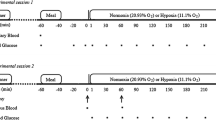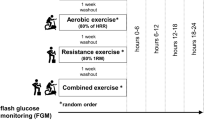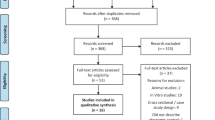Abstract
Purpose
Intermittent hypoxia training/treatment (IHT) is an emerging therapeutic approach to alleviate chronic diseases, such as diabetes. The present study investigated the effects of IHT on blood leucocyte pyruvate dehydrogenase kinase 1 (PDK-1) mRNA expression and its relationship with the changes in blood insulin level.
Methods
Seven adult healthy volunteers and 11 prediabetic patients participated in this study. A 3-week course of IHT consisted of a 40-min session of 4 cycles of 5-min 12% O2 and 5-min room air breathing per day, 3 sessions per week for 3 weeks (i.e., total 9 sessions of IHT). Plasma insulin levels and leukocyte PDK-1 mRNA expression were determined at various time points either under fasting condition or following oral glucose tolerance test (OGTT). Correlation between the IHT-induced changes in PDK-1 mRNA and insulin or glucose levels in the same serological samples was analyzed.
Results
At pre-IHT baseline, PDK-1 mRNA expression was two times higher in prediabetes than control subjects. IHT resulted in significant augmentation in PDK-1 mRNA expression (> twofold) in prediabetes at the end of 3-week IHT and remained elevated 1 month after IHT, which was correlated with a significantly reduced insulin release and lower blood glucose after glucose loading with OGTT.
Conclusion
IHT can trigger beneficial effects in normalizing blood insulin levels in prediabetic patients under oral glucose load, which were closely correlated with an enhanced mRNA expression of PDK-1 in leukocytes. Further clinical trials are warranted to validate the utility of IHT as a non-invasive complementary therapy against diabetes-associated pathologies.





Similar content being viewed by others
Abbreviations
- ANOVA:
-
Analysis of variance
- GLUT:
-
Glucose transporter
- HIF-1α:
-
Hypoxia inducible factor 1α
- IHT:
-
Intermittent hypoxia training/treatment
- INSR:
-
Insulin receptor
- OGTT:
-
Oral glucose tolerance test
- PDH:
-
Pyruvate dehydrogenase
- PDK:
-
Pyruvate dehydrogenase kinase
- PDK-1:
-
Pyruvate dehydrogenase kinase 1
- R:
-
Correlation coefficient
- SD:
-
Standard Deviation
- TCA:
-
Tricarboxylic acid cycle
References
Camacho-Cardenosa A, Camacho-Cardenosa M, Burtscher M, Martinez-Guardado I, Timon R, Brazo-Sayavera J, Olcina G (2018) High-intensity interval training in normobaric hypoxia leads to greater body fat loss in overweight/obese women than high-intensity interval training in normoxia. Front Physiol 9:60
Carreras A, Kayali F, Zhang J, Hirotsu C, Wang Y, Gozal D (2012) Metabolic effects of intermittent hypoxia in mice: steady versus high-frequency applied hypoxia daily during the rest period. Am J Physiol Regul Integr Comp Physiol 303(7):R700–R709
Costalat G, Lemaitre F, Tobin B, Renshaw G (2018) Intermittent hypoxia revisited: a promising non-pharmaceutical strategy to reduce cardio-metabolic risk factors? Sleep Breath 22(1):267–271
Dudnik E, Zagaynaya E, Glazachev OS, Susta D (2018) Intermittent hypoxia-hyperoxia conditioning improves cardiorespiratory fitness in older comorbid cardiac outpatients without hematological changes: a randomized controlled trial. High Alt Med Biol 19(4):339–343
Essop MF (2007) Cardiac metabolic adaptations in response to chronic hypoxia. J Physiol 584(3):715–726
Ferriero R, Iannuzzi C, Manco G, Brunetti-Pierri N (2015) Differential inhibition of PDKs by phenylbutyrate and enhancement of pyruvate dehydrogenase complex activity by combination with dichloroacetate. J Inherit Metab Dis 38(5):895–904
Genuth S, Alberti KG, Bennett P, Buse J, Defronzo R, Kahn R, Kitzmiller J, Knowler WC, Lebovitz H, Lernmark A, Nathan D, Palmer J, Rizza R, Saudek C, Shaw J, Steffes M, Stern M, Tuomilehto J, Zimmet P (2003) Follow-up report on the diagnosis of diabetes mellitus. Diabetes Care 26(11):3160–3167
Göhring I, Sharoyko VV, Malmgren S, Andersson LE, Spégel P, Nicholls DG, Mulder H (2014) Chronic high glucose and pyruvate levels differentially affect mitochondrial bioenergetics and fuel-stimulated insulin secretion from clonal INS-1 832/13 cells. J Biol Chem 289(6):3786–3798
Gozal D, Gileles-Hillel A, Cortese R, Li Y, Almendros I, Qiao Z, Khalyfa AA, Andrade J, Khalyfa A (2017) Visceral white adipose tissue after chronic intermittent and sustained hypoxia in mice. Am J Respir Cell MolBiol 56(4):477–487
Halvarsson C, Eliasson P, Jönsson JI (2017) Pyruvate dehydrogenase kinase 1 is essential for transplantable mouse bone marrow hematopoietic stem cell and progenitor function. PLoS One 12(2):e0171714
Hao K, Kong FP, Gao YQ, Tang JW, Chen J, Evans AM, Lightman SL, Chen XQ, Du JZ (2015) Inactivation of corticotropin-releasing hormone-induced insulinotropic role by high-altitude hypoxia. Diabetes 64(3):785–795
Hollinshead KE, Tennant DA (2016) Mitochondrial metabolic remodeling in response to genetic and environmental perturbations. Wiley Interdiscip Rev Syst Biol Med 8(4):272–285
Huang B, Wu P, Bowker-Kinley MM, Harris RA (2002) Regulation of pyruvate dehydrogenase kinase expression by peroxisome proliferator-activated receptor-alpha ligands, glucocorticoids, and insulin. Diabetes 51(2):276–283
Jeoung NH (2015) Pyruvate dehydrogenase kinases: Therapeutic targets for diabetes and cancers. Diabetes Metab J 39(3):188–197
Kelly KR, Williamson DL, Fealy CE, Kriz DA, Krishnan RK, Huang H, Ahn J, Loomis JL, Kirwan JP (2010) Acute altitude-induced hypoxia suppresses plasma glucose and leptin in healthy humans. Metabolism 59(2):200–205
Khan AUH, Allende-Vega N, Gitenay D, Gerbal-Chaloin S, Gondeau C, Vo DN, Belkahla S, Orecchioni S, Talarico G, Bertolini F, Bozic M, Valdivielso JM, Bejjani F, Jariel I, Lopez-Mejia IC, Fajas L, Lecellier CH, Hernandez J, Daujat M, Villalba M (2017) The PDK1 inhibitor dichloroacetate controls cholesterol homeostasis through the ERK5/MEF2 Pathway. Sci Rep 7(1):10654
Kim JW, Tchernyshyov I, Semenza GL, Dang CV (2006) HIF-1-mediated expression of pyruvate dehydrogenase kinase: a metabolic switch required for cellular adaptation to hypoxia. Cell Metab 3(3):177–185
Kolesnyk IU, Orestenko I, Seredenko MM, Abramov AV (1994) The effect of intermittent hypoxic training on pancreatic endocrine function in animals with diabetes mellitus. Fiziol Zh 40(5–6):87–95
Kolesnyk I, Kadzharian I, Abramov AV (2013) The influence of the intermittent hypoxia trainings on the functional status of corticoliberin- and beta-endorphin-synthesizing neurons of the paraventricular nucleus hypothalamus in rats. Fiziol Zh 59(6):25–29
Krus U, Kotova O, Spegel P, Hallgard E, Sharoyko VV, Vedin A, Moritz T, Sugden MC, Koeck T, Mulder H (2010) Pyruvate dehydrogenase kinase 1 controls mitochondrial metabolism and insulin secretion in INS-1 832/13 clonal beta-cells. Biochem J 429(1):205–213
Kulkarni SS, Salehzadeh F, Fritz T, Zierath JR, Krook A, Osler ME (2012) Mitochondrial regulators of fatty acid metabolism reflect metabolic dysfunction in type 2 diabetes mellitus. Metabolism 61(2):175–185
Lee IK (2014) The role of pyruvate dehydrogenase kinase in diabetes and obesity. Diabetes Metab J 38(3):181–186
Lee EJ, Alonso LC, Stefanovski D, Strollo HC, Romano LC, Zou B, Singamsetty S, Yester KA, McGaffin KR, Garcia-Ocana A, O’Donnell CP (2013) Time-dependent changes in glucose and insulin regulation during intermittent hypoxia and continuous hypoxia. Eur J Appl Physiol 113(2):467–478
Louis M, Punjabi NM (2009) Effects of acute intermittent hypoxia on glucose metabolism in awake healthy volunteers. J Appl Physiol 106(5):1538–1544
Mackenzie RW, Watt P (2016) A Molecular and Whole Body Insight of the Mechanisms Surrounding Glucose Disposal and Insulin Resistance with Hypoxic Treatment in Skeletal Muscle. J Diabetes Res, 2016:6934937
Mackenzie R, Maxwell N, Castle P, Elliott B, Brickley G, Watt P (2012) Intermittent exercise with and without hypoxia improves insulin sensitivity in individuals with type 2 diabetes. J Clin Endocrinol Metab 97(4):E546–E555
Mallet RT, Manukhina EB, Ruelas SS, Caffrey JL, Downey HF (2018) Cardioprotection by intermittent hypoxia conditioning: Evidence, mechanisms and therapeutic potential. Am J Physiol Heart CircPhysiol 315(2):H216–H232
Minchenko O, Opentanova I, Minchenko D, Ogura T, Esumi H (2004) Hypoxia induces transcription of 6-phosphofructo-2-kinase/fructose-2,6-biphosphatase-4 gene via hypoxia-inducible factor-1alpha activation. FEBS Lett 576(1–2):14–20
Morishima T, Hasegawa Y, Sasaki H, Kurihara T, Hamaoka T, Goto K (2015) Effects of different periods of hypoxic training on glucose metabolism and insulin sensitivity. ClinPhysiol Funct Imaging 35(2):104–109
Nam H, Jones D, Cooksey RC, Gao Y, Sink S, Cox J, McClain DA (2016) Synergistic inhibitory effects of hypoxia and iron deficiency on hepatic glucose response in mouse liver. Diabetes 65(6):1521–1533
Navarrete-Opazo A, Mitchell GS (2014) Therapeutic potential of intermittent hypoxia: a matter of dose. Am J Physiol Regul Integr Comp Physiol 307(10):R1181–R1197
Newhouse LP, Joyner MJ, Curry TB, Laurenti MC, Man CD, Cobelli C, Vella A, Limberg JK (2017) Three hours of intermittent hypoxia increases circulating glucose levels in healthy adults. Physiol Rep 5(1):e13106
Nguyen DD, Kim G, Pae EK (2016) Modulation of muscle fiber compositions in response to hypoxia via pyruvate dehydrogenase kinase-1. Front Physiol 7:604
Papandreou I, Cairns RA, Fontana L, Lim AL, Denko NC (2006) HIF-1 mediates adaptation to hypoxia by actively downregulating mitochondrial oxygen consumption. Cell Metab 3(3):187–197
Park S, Jeon JH, Min BK, Ha CM, Thoudam T, Park BY, Lee IK (2018) Role of the pyruvate dehydrogenase complex in metabolic remodeling: differential pyruvate dehydrogenase complex functions in metabolism. Diabetes Metab J 42(4):270–281
Peltonen GL, Scalzo RL, Schweder MM, Larson DG, Luckasen GJ, Irwin D, Hamilton KL, Schroeder T, Bell C (2012) Sympathetic inhibition attenuates hypoxia induced insulin resistance in healthy adult humans. J Physiol 590(11):2801–2809
Peters SJ, Harris RA, Wu P, Pehleman TL, Heigenhauser GJ, Spriet LL (2001) Human skeletal muscle PDH kinase activity and isoform expression during a 3-day high-fat/low-carbohydrate diet. Am J Physiol Endocrinol Metab 281(6):E1151–E1158
Portnichenko VI, Portnychenko AH, Surova OV (2009) Hypoglycemia and gene induction in rat myocardium and lungs at hypobaric hypoxia. Achiev Clin Exp Med 2:65–68
Portnichenko VI, Nosar VI, Sydorenko AM, Portnichenko AH, Man’kovs’ka IM (2012a) Continuous adaptation of rats to hypobaric hypoxia prevents stressor hyperglycemia and optimizes mitochondrial respiration under acute hypoxia. Fiziol Zh 58(5):56–64
Portnichenko VI, Nosar VI, Portnichenko AG, Drevitskaia TI, Sidorenko AM, Man’kovskaia IN (2012b) Phase changes in energy metabolism during periodic hypoxia. Fiziol Zh 58(4):3–12
Roberts AC, Reeves JT, Butterfield GE, Mazzeo RS, Sutton JR, Wolfel EE, Brooks GA (1996) Altitude and beta-blockade augment glucose utilization during submaximal exercise. J Appl Physiol 80(2):605–615
Ryden L, Standl E, Bartnik M, Van den Berghe G, Betteridge J, de Boer MJ, Cosentino F, Jonsson B, Laakso M, Malmberg K, Priori S, Ostergren J, Tuomilehto J, Thrainsdottir I, Vanhorebeek I, Stramba-Badiale M, Lindgren P, Qiao Q, Priori SG, Blanc JJ, Budaj A, Camm J, Dean V, Deckers J, Dickstein K, Lekakis J, McGregor K, Metra M, Morais J, Osterspey A, Tamargo J, Zamorano JL, Deckers JW, Bertrand M, Charbonnel B, Erdmann E, Ferrannini E, Flyvbjerg A, Gohlke H, Juanatey JR, Graham I, Monteiro PF, Parhofer K, Pyorala K, Raz I, Schernthaner G, Volpe M, Wood D (2007) Guidelines on diabetes, pre-diabetes, and cardiovascular diseases: executive summary. The task force on diabetes and cardiovascular diseases of the European society of cardiology (ESC) and of the European association for the study of diabetes (EASD). Eur Heart J 28(1):88–136
Sakata S, Shimizu S, Kishi T, Hirai K, Mori I, Ohno Y, Ueda M, Takaki M, Kohzuki H, Okamoto S, Shimamoto I, Yanagi S, Ogoshi K, Sherchand JB (2000) Correlation between erythropoietin and lactate in humans during altitude exposure. Jpn J Physiol 50(2):285–288
Serebrovska TV, Portnychenko AG, Drevytska TI, Portnichenko VI, Xi L, Egorov E, Gavalko AV, Naskalova S, Chizhova V, Shatylo VB (2017) Intermittent hypoxia training in prediabetes patients: Beneficial effects on glucose homeostasis, hypoxia tolerance and gene expression. Exp Biol Med 242(15):1542–1552
Serebrovskaya TV (2002) Intermittent hypoxia research in the former soviet union and the commonwealth of independent States: history and review of the concept and selected applications. High Alt Med Biol 3(2):205–221
Serebrovskaya TV, Xi L (2016) Intermittent hypoxia training as non-pharmacologic therapy for cardiovascular diseases: Practical analysis on methods and equipment. Exp Biol Med 241(15):1708–1723
Sugden MC, Bulmer K, Augustine D, Holness MJ (2001) Selective modification of pyruvate dehydrogenase kinase isoform expression in rat pancreatic islets elicited by starvation and activation of peroxisome proliferator-activated receptor-alpha: implications for glucose-stimulated insulin secretion. Diabetes 2001 50(12):2729–2736
Sutendra G, Michelakis ED (2013) Pyruvate dehydrogenase kinase as a novel therapeutic target in oncology. Front Oncol 3:38
Tian YM, Liu Y, Wang S, Dong Y, Su T, Ma HJ, Zhang Y (2016) Anti-diabetes effect of chronic intermittent hypobaric hypoxia through improving liver insulin resistance in diabetic rats. Life Sci 150:1–7
Verges S, Chacaroun S, Godin-Ribuot D, Baillieul S (2015) Hypoxic conditioning as a new therapeutic modality. Front Pediatr 3:58
Wang Y, Hai B, Niu X, Ai L, Cao Y, Li R, Li Y (2017) Chronic intermittent hypoxia disturbs insulin secretion and causes pancreatic injury via the MAPK signaling pathway. Biochem Cell Biol 95(3):415–420
Wu CY, Tso SC, Chuang JL, Gui WJ, Lou M, Sharma G, Khemtong C, Qi X, Wynn RM, Chuang DT (2018) Targeting hepatic pyruvate dehydrogenase kinases restores insulin signaling and mitigates ChREBP-mediated lipogenesis in diet-induced obese mice. Mol Metab 12:12–24
Xu J, Han J, Epstein PN, Liu YQ (2006) Regulation of PDK mRNA by high fatty acid and glucose in pancreatic islets. Biochem Biophys Res Commun 344(3):827–833
Zhou X, Yu S, Su J, Sun L (2016) Computational study on new natural compound inhibitors of pyruvate dehydrogenase kinases. Int J Mol Sci 17(3):340
Acknowledgements
The authors like to thank Valentina Chizhova for clinical examination of the subjects and Tetiana I. Drevytska for performing gene expression analysis.
Author information
Authors and Affiliations
Contributions
All authors participated in the design and interpretation of the studies, data analysis, review, and final approval of the manuscript. TVS designed the study and wrote the manuscript. TVS, AGP, VIP, EE, IAS, SN, and VBS elaborated the study protocols and performed statistical analyses of the results. LX critically edited and final-assembled the manuscript. VBS provided the enrollment and clinical examination of the subjects as well as general research management.
Corresponding authors
Ethics declarations
Conflict of interest
LX is a co-founder of Xiamen Innovo Medical Technology Co. Ltd., Xiamen, China and EE is an owner of CellGym Technologies GmbH, Berlin, Germany. All other authors declare no potential conflicts of interest with respect to the research, authorship, and publication of this article.
Ethical approval
The research protocols, patient health information and informed consent forms were approved by the Ethics Committee of Chebotarev Institute of Gerontology, Kiev, Ukraine. This human study was performed in accordance with the ethical standards according to the 1964 Declaration of Helsinki.
Informed consent
Informed consent was obtained from all individual participants included in this study.
Additional information
Communicated by Guido Ferretti.
Publisher’s Note
Springer Nature remains neutral with regard to jurisdictional claims in published maps and institutional affiliations.
Rights and permissions
About this article
Cite this article
Serebrovska, T.V., Portnychenko, A.G., Portnichenko, V.I. et al. Effects of intermittent hypoxia training on leukocyte pyruvate dehydrogenase kinase 1 (PDK-1) mRNA expression and blood insulin level in prediabetes patients. Eur J Appl Physiol 119, 813–823 (2019). https://doi.org/10.1007/s00421-019-04072-2
Received:
Accepted:
Published:
Issue Date:
DOI: https://doi.org/10.1007/s00421-019-04072-2




